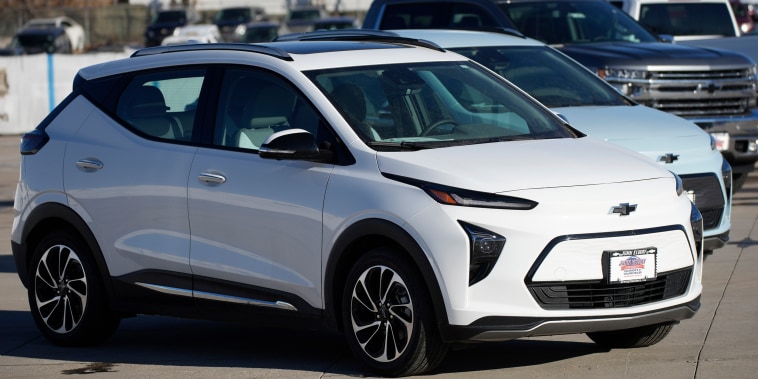Car buyers are watching the clock tick down for the Inflation Reduction Act’s updated electric vehicle tax incentives to kick in. The changes, which take effect next month, are likely to put EVs within closer reach for more consumers, experts say, but those with tighter budgets might benefit by holding off a bit longer.
“If you are ready to buy an EV that currently qualifies for the EV tax credit, jump on it,” said Jay Turner, an environmental studies professor at Wellesley College and author of “Charged: A History of Batteries and Lessons for a Clean Energy Future.” “Things get a lot more complicated next year.”
Among other provisions, the IRA includes limits on income and vehicle price that determine whether consumers get $7,500, $3,750 or $0 to put toward an electric vehicle. For example, a qualifying buyer’s modified adjusted gross income must not exceed $150,000 (or $300,000 for couples), and a new EV purchase must not exceed $80,000 for SUVs or $55,000 for sedans.
Thus far, said Tyson Jominy, vice president of data and analytics at J.D. Power, “the EV space has been dominated by a lot of wealthy consumers, very high-end vehicles. Part of the goal is to get down to middle-class levels.”
But the new law isn’t just trying to boost EVs’ appeal to get more drivers to go electric. It’s also trying to rev up the nation’s domestic EV production to boost made-in-USA inventories. As the legislation tries to balance both objectives by gradually phasing in multiple policies, the outlook can get confusing. Here’s an overview of what to expect, depending partly on your budget.
If you shop right now
State and federal EV incentives already exist. And when the IRA takes effect on Jan. 1, 2023, some existing policies will change. One addition: To receive the full federal tax credit, an EV must be assembled in North America and contain more components sourced there as well as more battery minerals derived on the continent or from a U.S. trade partner.
Chevy Bolt electric vehicles sit in an empty storage lot at a dealership in Englewood, Colo., on Feb. 27.David Zalubowski / AP
Abigail Bilbrey and her husband, Scott Wilson, recently bought a Nissan Leaf, before those restrictions kick in. The Boston-area couple, who make under $100,000 combined, said the existing set of tax credits on offer sealed the deal for them. Their car was built in Tennessee and qualified for the full $7,500 federal tax credit, which they were able to combine with a Massachusetts EV tax exemption of $2,500, effectively knocking $10,000 off the price.
“It was the EV that was the most efficient in terms of costs, so that’s what won us out,” Bilbrey said.
But so far, EV supplies remain limited, and there are waiting lists for some popular models. Plus, caps on how many vehicles can qualify for existing tax incentives have kept some buyers on the sidelines. Those limits go away next year, which may make it a good time to take a fresh look at the market.
If you shop in 2023
The federal cap allowing only 200,000 EVs per manufacturer to qualify for tax relief remains in place through this month. After those curbs lift in January, maxed-out automakers like Tesla and GM can qualify for the incentives. However, the North America production restrictions also kick in and gradually increase each year after that. At the same time, the law expands incentives to include fuel cell EVs, and used EVs will for the first time be eligible for a federal one-time tax credit of up to $4,000.
Analysts expect the complicated push-and-pull of these policies to produce a somewhat more accessible market that still generally favors buyers with more money to spend. And incentives notwithstanding, inflation and supply chain woes are continuing to goose car values: The average price of a new EV is $65,041, according to Kelley Blue Book, and Cox Automotive estimates current prices at roughly 9% higher than a year ago.
While some major automakers, including Hyundai, Kia and Honda, have announced plans to ramp up U.S. manufacturing so they can offer more incentive-qualifying vehicles, it’s not yet clear which automakers will be able to offer the full $7,500 credit.
“If you wouldn’t do it without a tax credit, I’m not sure that’s the reason to do it” under the new incentive structure, said Stephanie Brinley, associate director of research and analysis at S&P Global. But, she said, “if you’re talking about somebody who’s buying a $45,000 car and they can get enough for the credit, it can help.”
Electric vehicles bound for shipment to the U.S. at a port in Haiphong, Vietnam, on Nov. 25.Linh Pham / Bloomberg via Getty Images
The credit for used EVs comes with a lot of fine print: An individual’s modified adjusted gross income can’t exceed $75,000, and the vehicle must be at least two model-years old. Jessica Caldwell, executive director of insights at Edmunds, said a $25,000 price cap for used EVs further limits selection. Right now, she’s advising buyers to hold out for higher-quality inventory.
“The cap for used EVs is so low that we’re just not there from a pricing standpoint,” she said.
If you shop in 2024
After next year, the IRA makes an important change to how consumers apply their tax credit. Rather than having to wait to file their taxes to receive it, buyers will be able to cash in directly at dealerships. For many shoppers, that alone might be worth the wait.
“Some consumers at lower income brackets may not have enough tax to offset, and they may say, ‘Well, wait a minute, I thought I was supposed to get more money here,’” Jominy said. “With point of sale, that won’t be an issue.” Bilbrey and Wilson, by contrast, won’t get their credit until next year.
By 2024, industry experts say the EV market will probably look a bit different for other reasons, too. For example, while many auto executives and consumers have complained about the IRA’s North America-focused battery requirements — and regulators are actively seeking feedback that could result in changes — its provisions are still expected to broaden the selection of EVs in the not-so-long term.
That’s good news for those with tighter budgets, Caldwell said. While it’s a gamble whether a given EV will have met the IRA’s manufacturing standards by 2024, “waiting a year is probably going to be more helpful, just from an availability standpoint, which translates into a pricing standpoint,” she said. In October, GM CEO Mary Barra told analysts it would be “two to three years” before the company — which makes the Chevy Bolt, among the cheapest new EVs on the market at $25,600 — can offer buyers the full $7,500 credit.
Industry insiders are also betting that other pricing pressures, including the microchip shortage and high interest rates, will have abated somewhat by then too. As Wellesley’s Jay Turner sees it, the new law is “messy” but seems poised to make EVs more affordable — eventually.
“Long term, the IRA provisions will likely improve accessibility,” he said, “but it’ll be a bumpy road getting there.”



























